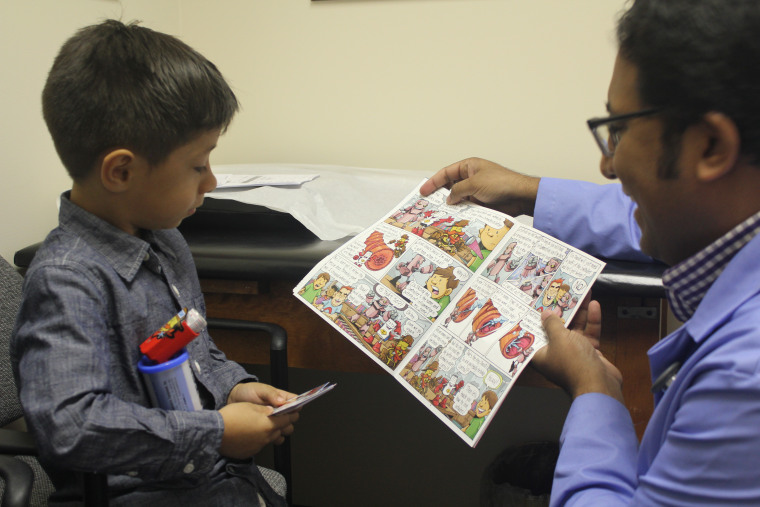Broncho the Bronchodilator? Coltron the Controller? It's Iggy and the Inhalers to the rescue!
When Dr. Alex Thomas noticed that children and their parents often struggled to understand asthma and sometimes confused the different types of medications, he set out to do something to help patients from exacerbating their condition.
"If you ask a 9-year-old to explain dinosaurs or Pokemon, they could tell you everything," Thomas, a Chicago-based pediatric allergist and cartoonist, told NBC News. "But have them describe a bronchodilator, and it's confusing. It's not that they don't have the capacity. So that's how we styled this...using characters to describe what inhalers they should be using."
Thomas recalled the childhood sketches and cartoon characters he used to draw for his mother, who was also a pediatric allergist. He then teamed up with an old classmate, health communication specialist Gary Ashwal, to create Booster Shot Comics and to turn his childhood sketches into comic books, YouTube videos, posters, trading cards, inhaler stickers, and a whole educational program.
More importantly, children and their families now have an easier time understanding and managing their asthma.
According to the Centers for Disease Control and Prevention (CDC), asthma is one of the most common long-term diseases affecting children, as well as adults, affecting one in 12 Americans, or 25 million people.
NBC News caught up with Dr. Thomas in between his sketches to talk about Booster Shot Comics and "Iggy and the Inhalers."
Are you a doctor who draws comics? Or a cartoonist who also gives medical care? Why did you start drawing these comics?
Rather than a physician that started drawing comics, I would say that I'm a cartoonist that became a physician that uses comics to educate patients. I’ve been drawing comics since childhood, but I was also interested in medicine from an early age. As an undergraduate at Northwestern University, I majored in Art-Theory and Practice and was a cartoonist for the daily paper, but I was also pre-med.
Believe it or not, I initially created many of the characters from “Iggy and the Inhalers” when I was 11 years old. As a child with asthma myself, I found myself both confused and a little overwhelmed by my illness. To help try to makes sense of it, I created characters out of the medications I was using, and “Iggy and the Inhalers” was born.
My mother, who also is a pediatric allergist, ran an allergy support group at the time, and in exchange for me typing up her quarterly newsletter, I was allowed to draw an “Iggy the Inhaler” comic in each newsletter.
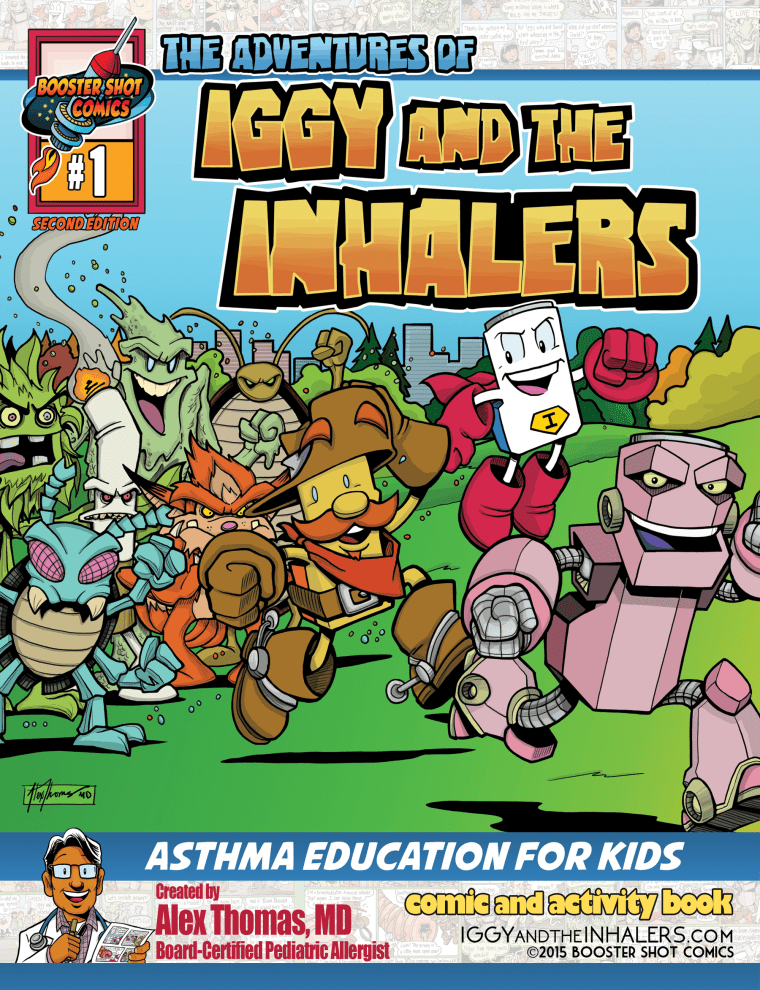
How did the project grow?
The current incarnation of “Iggy and the Inhalers” began during my time as a pediatric resident physician at the University of Wisconsin-Madison. I was working on the wards and in the ICU at the time, and began to notice a pattern in the children that were being admitted—and readmitted—for asthma exacerbations. In the majority of those kids, there was a fundamental confusion regarding the appropriate use of their different medications, or their triggers of asthma.
"The mother breathed a sigh of relief and said, 'Okay, this is the first time I've actually understood what asthma is.'"
We live in a time where asthma medications, when prescribed and used appropriately, can prevent exacerbations requiring hospitalizations in most kids. However, a major issue for families of children with asthma is that inhalers that do completely different things and should be used in completely different ways can look identical. I often would find patients inadvertently using their short acting quick reliever inhaler—which works in minutes, but wears off in hours—as their daily controller inhaler, and using their controller inhaler—which is slow acting and must be used every day to control airway inflammation—as a rescue inhaler as needed.
I thought about my nephew, who at the time was obsessed with "Pokemon" and had a seemingly encyclopedic knowledge of them. He could rattle off the specific strengths and weaknesses of dozens of different Pokemon. It dawned on me that asthma medications also each had their own strengths and weaknesses, and triggers could easily be depicted as villainous monsters.
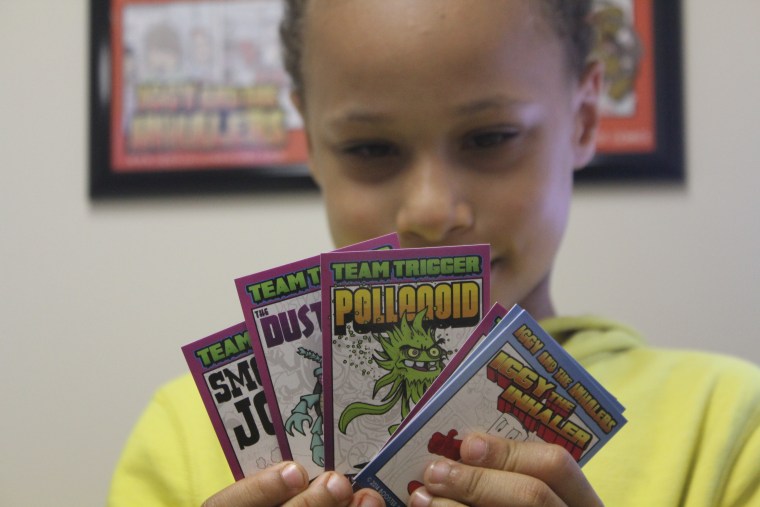
I realized that if I could make the characters and the comic book interesting enough, I could have children understand not just asthma pathophysiology, but also the specific mechanism of action of their medications. I thought that if kids (and their families) understood how their medications work, whey would be more likely to use them appropriately and avoid severe exacerbations that bring kids to the hospital.
What does “Iggy and the Inhalers” include now?
Iggy has grown from a comic book to a more comprehensive educational program. We completed a full color "Iggy and the Inhalers" comic/activity book and are currently printing our second edition, with input from asthma educators and other health education experts. We also created an animated video complete with a live-action inhaler demonstration, posters, trading cards, stickers and inhaler labels where kids can turn their inhalers in to the characters from the comic.
Last year, “Iggy and the Inhalers” was part of a school-based asthma education program in the Dane County public school system [in Wisconsin]. This past summer, the Iggy program was used in over 50 asthma camps nationwide. "Iggy and the Inhalers" is also being used by various public health departments, hospitals, and clinics across the country. We are constantly updating our materials to be up to date with current guidelines and standards of practice. We are also working on a mobile app as well as new episodes of the comic series.
What has the response been like? Tell us one great story about how a child has responded to your comics.
The response to "Iggy and the Inhalers" has been great. As a fellow at the University of Wisconsin, as we developed the educational materials, I would share them every summer at the Madison Asthma Camp, and I was always so pleased at how kids responded to things. For example, when given the trading cards, kids would tend to pick out the specific "Team Trigger" monsters that reflected their specific allergies. One child would pull out three cards and say "Oooh, I got Dust Mite, Roach, and Pollenoid!" While another would say, "Oh, I got Smokey Joe, Moldar, and Hairy." It was great seeing kids speak with each other openly about their allergies without any shame or embarrassment. It was empowering to the kids, and that was a thrill to see.
Now that I'm in private practice, I turned one of the exam rooms in my office into a patient education room. There, a child and his parents can watch the animated video, look at the educational posters on the wall, take stickers, read the comic book, and look at the trading cards. A few weeks back, I had a young patient around three years old with moderate persistent asthma whose parents were very overwhelmed with his new asthma diagnosis, and also non-compliant with his prescribed medications. He had already been to the Emergency Department multiple times in the past year and was admitted to the ICU once. I could tell that parents were very confused about the different medications he had to take and when he had to take them.
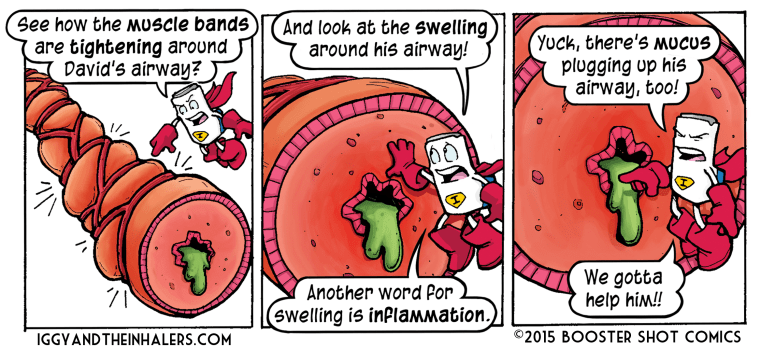
I brought them to the education room and had them watch the video and read through the materials. The young patient immediately began repeating lines from the animated video. After the video ended, I returned to the room to asthma pathophysiology and how the medications work using the posters and the comics. I could see a light bulb go off in their heads as they began to understand why their child needs the medications he is prescribed. The mother breathed a sigh of relief and said, "Okay, this is the first time I've actually understood what asthma is." Meanwhile, the three year old was watching the video reciting aloud why it was important to use an inhaler with a spacer.
From that day forward, the patient's parents have had no further problems in staying compliant with his medication regimen. I've seen him back a few times in follow up visits. On each visit, the child brings his comic book, asks to watch "the Iggy video" and continues to recite lines from it. His asthma has been very well-controlled and we've been able to step down on the doses of some of his medications.
After the many years Gary and I spent creating this educational program, it’s really gratifying to see it working the way we hoped it would.
How does asthma affect Asian-American children?
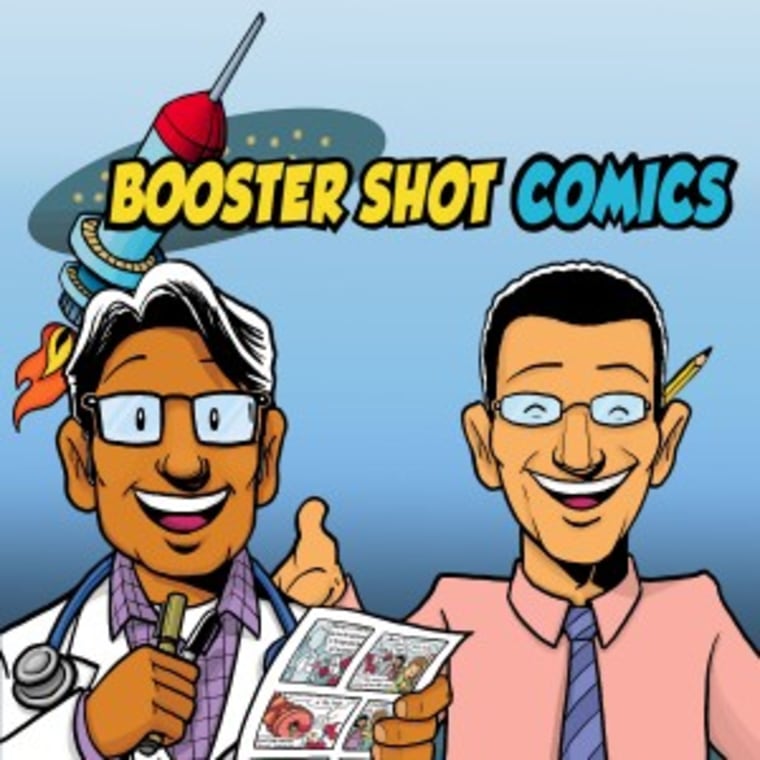
While the numbers of Asian-American children with asthma are not greater than other ethnic groups, there are particular struggles in dealing with asthma and allergies in the Asian-American community. For example, the young patient noted above whose family was struggling with good compliance was Asian American.
Rather than a physician that started drawing comics, I would say that I'm a cartoonist that became a physician that uses comics to educate patients.
In the past few years, I noted that there has been several asthma related deaths among kids in the Indian-American community in the area. As a result, our practice has been much more aggressive about asthma education and clinical outreach to the community. As I mentioned earlier, major issues are a poor understanding of asthma triggers, especially when visiting family abroad, and poor compliance to the prescribed medications. However, I believe that both of these are linked to a poor understanding of the child's underlying illness and treatment.
As an Indian American myself, I feel a strong responsibility to address some of the barriers there may in understanding asthma and why it is important to use prescribed medications correctly. For those reasons, whether it's meeting with our own patients, speaking at regional church meetings, teaching at Health Fairs or visiting schools, we have been making an extra effort to educate children and families in the Asian-American community in Chicagoland.
What are your future plans? More comics? More topics?
Beyond the topic of asthma and allergies, as Booster Shot Comics, we have been working on a variety of other projects. We recently collaborated with a Pediatric Emergency Department physician at Children’s Hospital of Wisconsin to create an educational comic book about pain identification and management for children in the Emergency Department. We also created a new pain scale to help kids quantify pain to their parents after being discharged from the hospital.
We also have been working with a variety of academic institutions to create “white board drawing” videos covering various topics. We recently produced a whiteboard video with to explain a research process to participants in the NIH-funded Pediatric HIV/AIDS Cohort Study (PHACS). We also recently created animated videos and comics for the NIH-funded study “Attitudes about the Ethics of Research on Medical Practice” with researchers at Seattle Children’s Hospital.
Gary and I are also currently working with the Stanford Center for Biomedical Ethics to produce a set of whiteboard animations for an NLM-funded project to assess attitudes related to the use of clinical data for research purposes. Those videos will be in English, Spanish, and Mandarin. We are currently working with the Johns Hopkins Berman Institute of Bioethics to create a series of whiteboard videos for a PCORI-funded research project on streamlined consent.
This interview has been edited for length and clarity.
